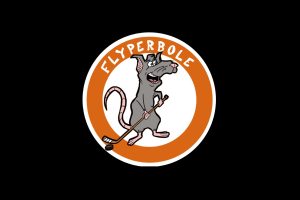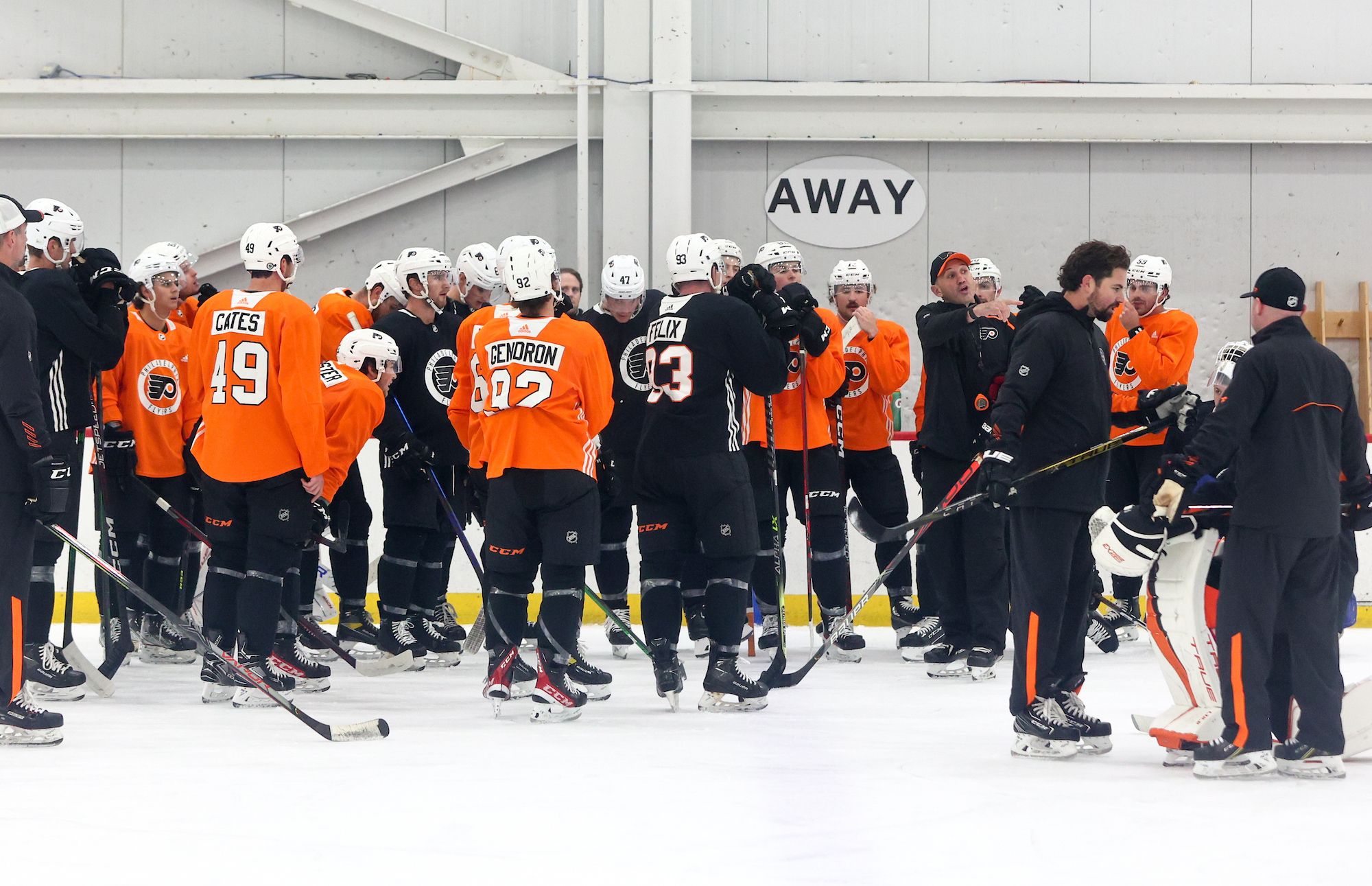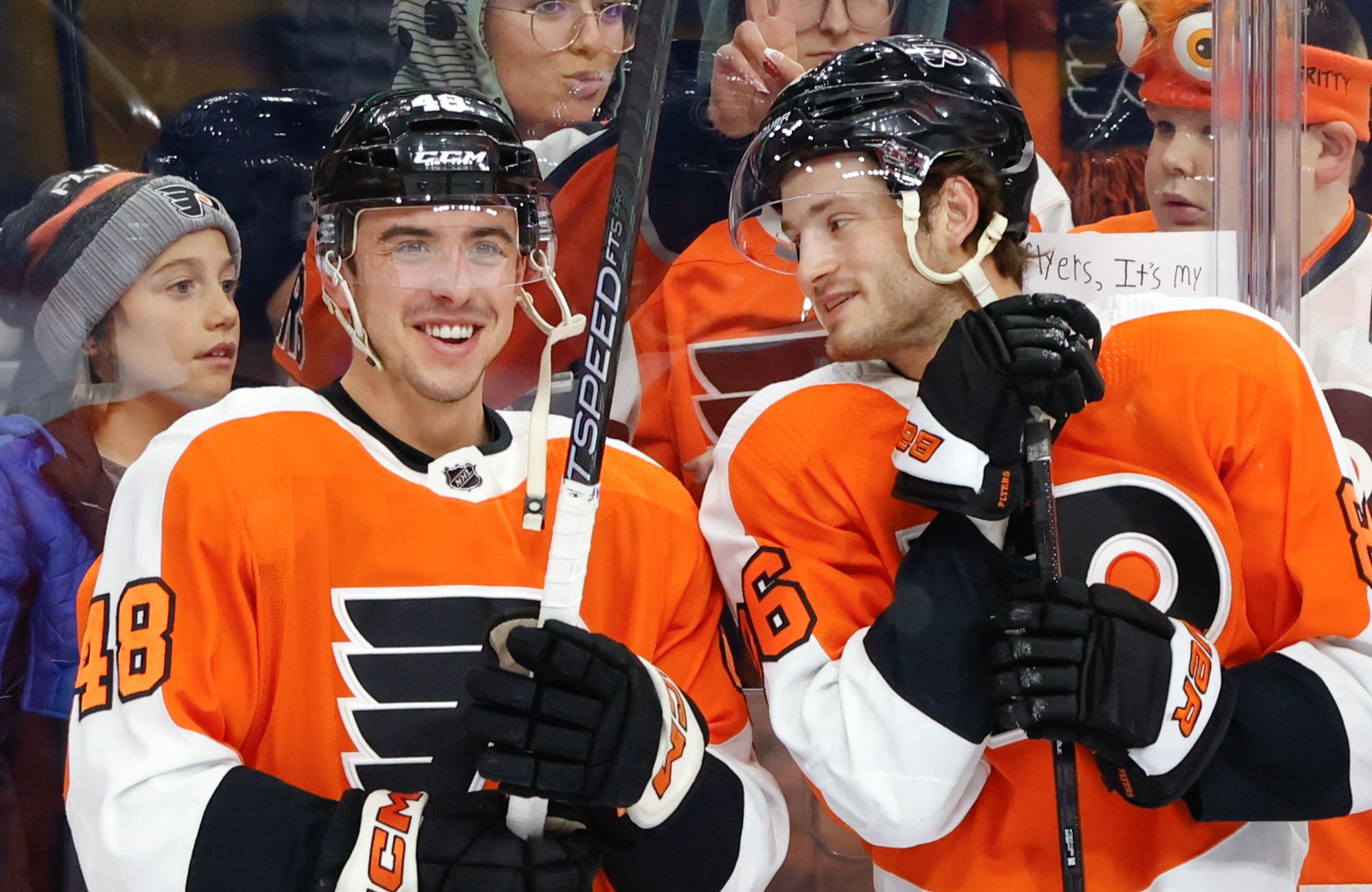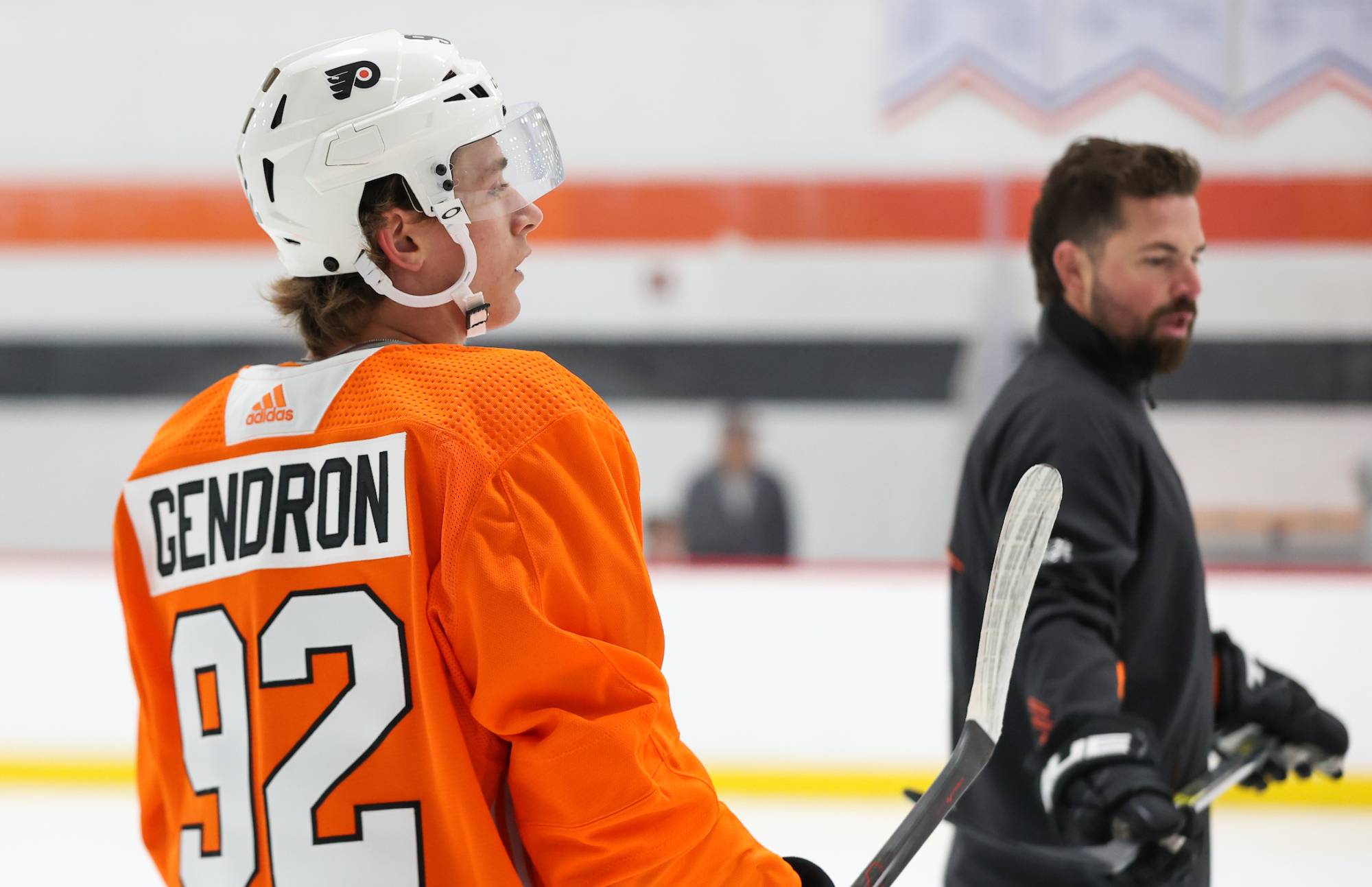Morning Observations is a feature where we break down the previous night’s game with an analytical eye.
#1: Early deficit aside, Flyers outplayed Senators all night
Philadelphia may have fallen behind 2-0 by the midpoint of last night’s contest against the Ottawa Senators, but the game had a similar feel as Tuesday’s versus the Bruins, except in reverse. The Sens took on the Flyers’ role from two nights earlier, overcoming poor territorial play with opportunistic tallies. Philadelphia of the present, on the other hand, was dominating the shots battle but simply could not beat Mike Condon, who got off to a great start and had an answer for every high-quality chance.
Unlike Boston, the Flyers didn’t wait until the third period to initiate their comeback, though. Instead, the onslaught came in the latter portion of the middle stanza, as Claude Giroux and Pierre-Edouard Bellemare scored in a 60-second span to even things up. But this wasn’t a case of the Flyers just getting lucky — they were simply being rewarded for their strong overall play to that point in the contest.
In the end, Philadelphia won all the key categories, a nice bounceback after getting pasted by the Bruins on Tuesday. Their solid 58.45% score-adjusted Corsi hinted at territorial dominance, while the 28-17 and 10-7 edge in regular and high-danger chances implies that they weren’t sacrificing quality for quantity.
#2: Giroux and Voracek took over this game
Even after Sean Couturier went down with a knee injury, Dave Hakstol chose to stick with the reunion of Claude Giroux and Jakub Voracek at 5-on-5, which had begun just a few games prior. The initial results were underwhelming, as the unit (with Brayden Schenn at left wing) struggled to drive play or create much of anything offensively. After a tweak that sent Schenn down the lineup and brought Michael Raffl back up, the top line has looked far more dangerous, scoring a few goals and generally buzzing on the attack. But last night was the first time this year that saw Giroux and Voracek back to their old ways as an elite duo.
They actually didn’t get off to a great start, hovering around the 50% Corsi mark despite the rest of the team comfortably driving play. But at the midpoint of the contest, the lightbulb flipped on. Suddenly, 28 and 93 were constantly on the attack, breaking Ottawa’s tight neutral zone checking and blasting away at Condon. Zone time without offensive creativity is limited in usefulness, but luckily both forwards brought that to the table with ease. Voracek took on the role of playmaker and puck protector, allowing for Giroux to be the finisher on the line.
The results were shift after shift of Voracek controlling the play with the puck, and two goals by Giroux — including the overtime gamewinner. Advanced metrics loved the duo’s play, as well. Voracek finished with a stellar 64.46% score-adjusted Corsi, and Giroux wasn’t far behind at 61.72%. For one night at least, the Flyers’ top two forwards turned back the clock to the 2013-14 season, when they were both on top of the hockey world. We’ll soon see if that was a one-off standalone show, or the beginning of a brand new series.
NHL.com Report & Highlights | Corsica.Hockey Game Recap Page | HockeyStats.ca Recap | NaturalStatTrick Recap | HockeyViz.com | BSH Recap | Meltzer’s Musings
#3: Flyers finally on a roll?
Last night marked Philadelphia’s third straight victory, the team’s longest winning streak of the season. Now three games may not be an especially long stretch, but considering the inconsistency of this Flyers squad so far this year, it’s encouraging to see them fall into something of a groove. Don’t forget that Black Friday’s loss (their last one) to the Rangers was a classic “good process, bad result” game, so one could argue that had they gotten any luck whatsoever seven days ago, we’d be staring at a very impressive four-game streak instead.
Still, if you’re going to note that the Rangers game “should have” been a win, it’s fair to admit that Steve Mason was the primary reason they topped Boston on Tuesday. At the same time, even accounting for the advanced stat shellacking by the Bruins, the Flyers have a 53.17% score-adjusted Corsi over their past four and a 52.51% xG percentage over that same period. This isn’t just good luck; Philadelphia has been playing legitimately strong hockey, especially at even strength. The schedule does turn tough now, though, with Chicago, Nashville, Florida and Edmonton all coming up. All four teams either have fearsome high-end talent, strong underlying metrics, or both. This will be a real challenge for the Flyers to continue with their solid play.
#4: MacDonald-Ghost pairing again stood out
I’ve been very critical this season of the play of Andrew MacDonald, on numerous occasions. My two primary arguments are that the Flyers have driven play significantly better with MacDonald on the bench versus when he is on the ice, and that dynamic defenseman Shayne Gostisbehere has been totally ineffective when paired with MacDonald yet is posting stellar results when separated from him. But over the past two games, the trend has seen a temporary halt. Not only has MacDonald generally passed the eye test and avoided the back-breaking miscues that marred his early-season play, his pairing with Gostisbehere has actually flourished by advanced metrics.
Last night, it was clearly the team’s most effective pairing, as Gostisbehere finished with a 79.94% score-adjusted Corsi and 69.64 xG%, while MacDonald finished close behind at 67.95% and 67.80%, respectively. Ghost has been driving play all year, so his numbers aren’t a big shock (except for the fact that they’re coming with this partner). But what about MacDonald? To my eyes, it appears he’s making a conscious effort to be more aggressive than usual when pinching in the offensive zone to keep cycles alive, and is even stepping up a bit more in the neutral zone to cut off plays. And when Gostisbehere starts to freelance deep, MacDonald has shown good recognition to stay back and provide cover for him.
To be sure, MacDonald wasn’t perfect last night, despite the stellar Corsi and xG. He allowed more than a couple clean entries by Ottawa forwards into the Flyers’ end, and has some poor shifts near the conclusion of regulation. But six-year, $30 million contract aside, Andrew MacDonald’s ceiling as an NHL player is not that of a top-pair defenseman. It’s of an inoffensive third-pair blueliner who limits obvious mistakes and doesn’t get totally destroyed territorially. You put a guy like that with Shayne Gostisbehere, and Ghost can still thrive. Over the past two nights, we’ve gotten that level of competency from MacDonald, and it’s been refreshing to see.
#5: Tightest period was the third
The Flyers got the better of play through the majority of the game, but to Ottawa’s credit, they pushed back in the third period after Philadelphia had tied things up at the conclusion of the middle stanza. In fact, the Senators were clearly the better squad through the period’s first ten minutes, shutting down attempts to move through the neutral zone and actually sending some tough shots in on Steve Mason. For a while, it looked like Philadelphia may have emptied the tank trying to comeback and simply were not prepared for Ottawa’s counterpunch.
The Flyers eventually got back going again, though. After generating just four shot attempts at 5v5 over the first ten minutes of the period, Philadelphia racked up 11 in the latter half, doing what they had to in order to push the contest to the 3v3 overtime where they would eventually prevail. In the end, the Senators generated 17 shot attempts to the Flyers’ 15, and just barely lost the scoring chance battle 8-7. Props to both teams — Ottawa for shaking off a poor initial 40 minutes to fight back late, and the Flyers for taking the Senators’ best punch with the game on the line and adjusting enough to retake control.
#6: Read an unsung hero
Dating back to his time as head coach of the Tampa Bay Lightning, Guy Boucher’s clubs have been known for the frustrating, tight checking neutral zone strategies. His Senators team doesn’t exclusively use the 1-3-1 formation that so infuriated Peter Laviolette back then, but they do employ it regularly, and even their other forechecks retain the same philosophy of clogging the middle and then initiating a quick transition rush. To get the better of a tough neutral zone system, you need a strong neutral zone player, and Matt Read fits the bill perfectly.
While not the scorer that he once was (early-season goal surge aside), he remains fantastic at getting the puck into the offensive zone and harassing opponents trying to do the same. It’s therefore not surprising that Read graded out well in this one, picking up an assist on the Flyers’ second goal and finishing with a strong 63.23% score-adjusted Corsi. As usual, Read was doing the little things to push play forward — winning foot races to loose pucks in the middle of the ice, stick lifts on players not in full control of it, creating 50/50 board battles rather than allowing clean exits or entries. This was a game that the Flyers really needed a smart role player like Matt Read, and he showed up from the opening whistle.
#7: Aggressive PK did slow down Flyers’ power play
For a power play that scores better than one out of every five times it hits the ice, a subsection of Flyers fans sure sound dissatisfied with it. Some of that seems due to a mistaken belief that the power play should score or look dangerous every time it hits the ice (unrealistic), while some stems from the relatively high number of shorthanded goals that the team has allowed so far this year. However, it’s undeniable that by the numbers, Philadelphia’s power play — particularly the top unit — has been fantastic this season. Even last night, which saw them finish 0-for-4, the top unit had its moments, but it was slowed by a particularly aggressive Ottawa penalty kill.
The Senators were attacking the half boards with reckless abandon, and the Philadelphia skill players did not respond particularly well, turning the puck over a fair amount. Still, the power play did have its moments, especially on the final full opportunity just after the midpoint of the second period. The numbers show a down night as well, but it’s important to note that a down night for the Flyers’ top unit from a shot generation standpoint is solid work for most other teams. With Giroux on the ice against Ottawa, the Flyers generated 96 shot attempts per 60 minutes. The average player on a top unit power play in 2015-16 posted a 97.61 CF60, so essentially, Giroux and company merely looked average relative to the league on Thursday, and that was on a night when they noticeably struggled to get things going.
#8: Borowiecki had one of the worst games I’ve seen
Giroux and Voracek were the Flyers’ MVPs on the night, but Mark Borowiecki certainly made a strong case to be star #3 — except for the Flyers, not for his own club. The Ottawa defenseman was an absolute disaster all night long, despite receiving over 19 minutes of ice time at 5v5. He took four minor penalties, three of which immediately led to Flyers power plays, and finished with an absolutely horrific 22.16% score-adjusted Corsi. In terms of raw shot attempts, Borowiecki was on the ice for eight Senators attempts and a whopping 30 by Philadelphia. Basically, every time Borowiecki hit the ice, the Flyers took full control of the game.
So how bad was his performance historically? Dom Luszczyszyn of The Hockey News created Game Score as a way of evaluating players on a nightly basis, a stat that compiles individual events like goals, assists and shots with on-ice events to create a number measuring a player’s single-game performance. Borowiecki finished last night’s contest with a -1.65, which would have been the worst score of any player in 2015-16. In other words, yes, Borowiecki delivered an especially notable disaster of a game, and the Flyers benefited greatly from it.
#9: Fourth line effective, but barely used
With Brayden Schenn now up on the second line with Travis Konecny and Wayne Simmonds, Nick Cousins was dropped down to play with Roman Lyubimov and Chris VandeVelde. Dave Hakstol very obviously used that trio as his fourth line last night, giving each forward less than 7:30 of 5-on-5 ice time. However, it wasn’t due to lack of on-ice results on the part of the skaters. Cousins finished with a team-high 82.19% score-adjusted Corsi, while Lyubimov was solid at 62.65% and VandeVelde passable with 57.80%. There appears to be some potential here, but it wasn’t rewarded with more ice time against the Sens. It will be interesting to see if that changes against Chicago on Saturday.
#10: Ottawa was a one-line team
On the Senators side, they were perfectly competitive with the Flyers whenever the trio of Derick Brassard, Mike Hoffman and Mark Stone hit the ice, and a total dumpster fire with them on the bench. All three of the forwards on Ottawa’s top line finished with score-adjusted Corsis over 58% percent, despite a number of shifts matched up against Giroux and his linemates. However, no other Senators forward even cracked 45 percent.
Ottawa is sitting pretty in the standings, but break down their roster and it appears to be severely lacking in depth. The top line and Kyle Turris are somewhere between good and great, and obviously Erik Karlsson is an incredible defenseman. But past those five and you’re looking at a lineup full of role players. The Flyers will need to jump a few teams currently in a playoff spot by the end of the year if they want their own, and I believe Ottawa is one such realistic target. In my estimation, they looked primed for a fall.









